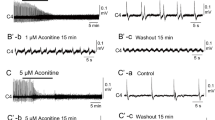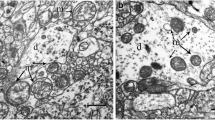Abstract
Tissue oxygen (PO2), K+ (aKe), pH (pHe) and Ca2+ ([Ca2+]e) were measured in the region of the ventral respiratory group (VRG) in the in vitro brainstem-spinal cord preparation of neonatal rats. During tissue anoxia, elicited by superfusion of N2-gassed solutions, an initial increase in the frequency of respiratory activity, lasting between 2 and 12 min, turned into a frequency depression. During anoxia periods of up to 60 min, respiratory activity persisted in solutions containing CO2/bicarbonate, whereas a complete blockade was observed after 15–25 min in N-2-hydroxyethylpiperazine-N′-2-ethanesulfonic acid- (Hepes)-buffered salines. After such anoxic apnea, respiratory rhythmicity could be reactivated by superfusion of hypoxic, CO2/bicarbonate-buffered solutions. In both types of hypoxic solutions, aKe increased by maximally 1.5mM, whereas an initial increase of pHe by up to 0.05 pH units turned, after 2–4 min, into an acidification which could exceed 0.5 pH units. In contrast, [Ca2+]e remained unaffected by anoxia. Addition of 2–5 mM cyanide (CN-) to oxygenated Hepes-buffered saline evoked an increase in PO2 in the VRG from 100 to more than 300 mmHg. The effects of CN- on respiratory activity, aKe and pHe were almost identical to those during anoxia. In oxygenated, CO2/bicarbonatefree solutions of different pH, however, an increase in pHe in the VRG led to a decrease in respiratory frequency, whereas a fall of pHe produced a frequency acceleration. A rise of aKe in the VRG by more than 2 mM as induced by superfusion of a 7 mM K+ solution led to a sustained increase of respiratory frequency. The results indicate that blockade of aerobic metabolism does not severely perturb K+ and Ca2+ homeostasis and that the biphasic response to anoxia is not directly related to the observed changes in PO2, aKe, pHe, or [Ca2+]e. In the respiratory network of neonatal mammals, CO2 might provide a stimulus for long-term maintenance of respiratory activity under oxygen depletion.
Similar content being viewed by others
References
Amman D (1986) Ion-selective microelectrodes. Springer, Berlin Heidelberg New York
Ballanyi K, Völker A, Richter DW (1994) Anoxia induced functional inactivation of neonatal respiratory neurons in vitro. Neuro report 6: (in press)
Ballanyi K, Grafe P, Reddy MM, Bruggencate G ten (1984) Different types of potassium transport linked to carbachol and γ-ammobutyric acid actions in rat sympathetic neurons. Neuroscience 12: 917–927
Ballanyi K, Kuwana S, Völker A, Morawietz G, Richter DW (1992) Developmental changes in the hypoxia tolerance of the vitro respiratory network of rats. Neurosci Lett 148: 141–144
Brockhaus J, Ballanyi K, Smith JC, Richter DW (1993) Microenvironment of respiratory neurons in the in vitro brain-stemspinal cord of neonatal rats. J Physiol (Lond) 462: 421–445
Brown DL, Lawson EE (1988) Brain stem extracellular fluid pH and respiratory drive during hypoxia in newborn pigs. J Appl Physiol 64: 1055–1059
Cherniack NS, Edelman NH, Lahiri S (1971) Hypoxia and hypercapnia as respiratory stimulants and depressants. Resp Physiol11: 113–126
Chesler M (1990) The regulation and modulation of pH in the nervous system. Prog Neurobiol 34: 401–427
Church J (1992) A change from HCO -3 -CO2-to Hepes-buffered medium modifies membrane properties of rat CA1 pyramidal neurones in vitro. J Physiol (Lond) 455: 51–71
Dean JB, Lawing WL, Millhorn DE (1989) CO2 decreases membrane conductance and depolarizes neurons in the nucleus tractus solitarii. Exp Brain Res 76: 656–661
Duffy TE, Kohle SJ, Vannucci RC (1975) Carbohydrate and energy metabolism in perinatal rat brain: relation to survival in anoxia. J Neurochem 24: 271–276
Eldridge FL, Kiley JP, Millhorn DE (1985) Respiratory response to medullary hydrogen ion changes in cat: different effects of respiratory and metabolic acidosis. J Physiol (Lond) 358: 285–297
Fazekas JF, Alexander FAD, Himwich HE (1941) Tolerance of the newborn to anoxia. Am J Physiol 134: 282–287
Fedorko L, Kelly EN, England SJ (1988) Importance of vagal afferents in determining ventilation in newborn rats. J Appl Physiol 65: 1033–1039
Feldman JL, Smith JC, Liu G (1991) Respiratory pattern generation in mammals: in vitro en bloc analyses. Curr Opin Neurobiol1: 590–594
Friedman J, Haddad GG (1993) Major differences in Ca2+ response to anoxia between neonatal and adult rat CA1 neurons; role of [Ca2+]0 and [Na+]0. J Neurosci 13: 63–72
Grote J, Zimmer K, Schubert R (1981) Effects of severe arterial hypocapnia on regional blood flow regulation in the brain cortex of cats. Pflugers Arch 391: 195–199
Haddad GG, Jiang C (1993) O2 deprivation in the central nervous system: on mechanisms of neuronal response, differential sensitivity and injury. Prog Neurobiol 40: 277–318
Haddad GG, Mellins RB (1984) Hypoxia and respiratory control in early life. Annu Rev Physiol 46: 629–643
Hansen AJ (1985) Effect of anoxia on ion distribution in the brain. Physiol Rev 65: 101–148
Harada Y, Kuno M, Wang YZ (1985) Differential effects of carbon dioxide and pH on central chemoreceptors in the rat in vitro. J Physiol (Lond) 368: 679–693
Kawai A, Mückenhoff K, Okada Y, Scheid P (1993) Effects of theophylline on hypoxic respiratory depression in the isolated brainstem-spinal cord preparation of the neonatal rat (abstract). Proc IUPS XXII: 282, 61
Kholwadwala D, Donnelly DF (1992) Maturation of carotid chemoreceptor sensitivity to hypoxia. In vitro studies in the neonatal rat. J Physiol (Lond) 453: 461–473
Kral T, Luhmann H, Mittmann T, Heinemann U (1993) Role of NMDA receptors and voltage-activated calcium channels in an in vitro model of cerebral ischemia. Brain Res 612: 278–288
Krnjevic K, Walz W (1990) Acidosis and blockade of orthodromic responses caused by anoxia in rat hippocampal slices at different temperatures. J Physiol (Lond) 422: 127–144
Kuwana S, Natsui T (1981) Effect of arterial H+ on threshold PCO2 of the respiratory system in vagotomized and carotid sinus nerve denervated cats. J Physiol (Lond) 318: 223–237
Kuwana S, Ballanyi K, Morawietz G, Völker A, Voipio J, Richter DW (1993) Chemosensitivity of the respiratory network of neonatal and mature rats (abstract). Proc IUPS XXXII: 1141.26P
Lawson EE, Long WA (1983) Central origin of biphasic breathing pattern during hypoxia in newborns. J Appl Physiol 55: 483–488
Lee L-Y, Millhorn HT (1975) Central ventilatory responses to O2 and CO2 at three levels of carotid chemoreceptor stimulation. Resp Physiol 25: 319–333
Loeschcke HH (1982) Central chemosensitivity and the reaction theory. J Physiol (Lond) 332: 1–24
Lopez-Barneo J, Lopez-Lopez JR, Urena J, Gonzalez C (1988) Chemotransduction in the carotid body: K+ current modulated by PO2 in type I chemoreceptor cells. Science 241: 580–582
Macefield G, Nail B (1987) Phrenic and external intercostal motoneuron activity during progressive asphyxia. J Appl Physiol63: 1413–1420
Millhorn DE, Eldridge FL, Kiley JP, Waldrop TG (1984) Prolonged inhibition of respiration following acute hypoxia in glomectomized cats. Resp Physiol 57: 331–340
Monteau R, Morin D, Hilaire G (1990) Acetylcholine and central chemosensitivity: in vitro study in the newborn rat. Resp Physiol 81: 241–254
Neubauer JA, Santiago TV, Posner MA, Edelman NH (1985) Ventral medullary pH and ventilatory responses to hyperperfusion and hypoxia. J Appl Physiol 58: 1659–1668
Neubauer JA, Simone A, Edelman NH (1988) Role of brain lactic acidosis in hypoxic depression of respiration. J Appl Physiol 65: 1324–1331
Neubauer JA, Melton JE, Edelman NH (1990) Modulation of respiration during brain hypoxia. J Appl Physiol 68: 441–451
Pumain R, Kurcewicz I, Louvel J (1987) Ionic changes induced by excitatory amino acids in the rat cerebral cortex. Can J Physiol Pharmacol 65: 1067–1077
Richter DW, Acker H (1989) Respiratory neuron behaviour during medullary hypoxia. In: Lahiri S (ed) Chemoreceptors and reflexes in breathing: cellular and molecular aspects. Oxford University Press, New York, pp 267–274
Richter DW, Bischoff A, Anders K, Bellingham M, Windhorst U (1991) Response of the medullary respiratory network of the cat to hypoxia. J Physiol (Lond) 443: 231–256
Rigatto H (1984) Control of ventilation in the newborn. Ann Rev Physiol 46: 661–674
Schäfer T, Morin-Surun M-P, Denavit-Saubie M (1993) Oxygen supply and respiratory-like activity in the isolated perfused brainstem of the adult guinea pig. Brain Res 618: 246–250
Sick TJ, Kreisman NR (1981) Potassium ion homeostasis in amphibian brain: contribution of active transport and oxidative metabolism. J Neurophysiol 45: 998–1012
Sick TJ, Rosenthal M, LaManna JC, Lutz PL (1982) Brain potassium homeostasis, anoxia, and metabolic inhibition in turtles and rats. Am J Physiol 243: R281-R288
Siesjö BK (1988) Calcium, ischemia, and death of brain cells. Ann NY Acad Sci 522: 638–661
Smith JC, Greer JJ, Liu G, Feldman JL (1990) Neural mechanisms generating respiratory pattern in mammalian brainstem-spinal cord in vitro. J Neurophysiol 64: 1149–1169
Smith JC, Ellenberger HH, Ballanyi K, Richter DW, Feldman JL (1991) Pre-Bötzinger complex: a brainstem region that may generate respiratory rhythm in mammals. Science 254: 726–729
Strupp M, Jund R, Schneider U, Grafe P (1991) Glucose availability and sensitivity to anoxia of isolated rat peroneal nerve Am J Physiol 261: E389-E394
Sykova E (1983) Extracellular K+ accumulation in the central nervous system. Prog Biophys Mol Biol 42: 135–189
Tombaugh GC, Sapolsky RM (1990) Mild acidosis protects hippocampal neurons from injury induced by oxygen and glucose depletion. Brain Res 506: 343–345
Trippenbach T, Richter DW, Acker H (1990) Hypoxia and ion activities within the brainstem of newborn rabbits. J Appl Physiol 68: 2494–2503
Vizek M, Pickett CK, Weil JV (1987) Biphasic ventilatory response to hypoxia has central origin. J Appl Physiol 63: 1658–1664
Völker A, Ballanyi K, Richter DW (1992) Metabolic disturbances of the in vitro respiratory network in neonatal rats (abstract). Pflugers Arch 420: R130
Voipio J, Ballanyi K (1993) Direct measurements of tissue pCO2 in the in vitro brainstem-spinal cord of neonatal rats. In: Elsner N, Heisenberg M (eds) Proceedings of 21st Göttingen Neurobiology Conference. Thieme, Stuttgart New York, p 331
Author information
Authors and Affiliations
Rights and permissions
About this article
Cite this article
Völker, A., Ballanyi, K. & Richter, D.W. Anoxic disturbance of the isolated respiratory network of neonatal rats. Exp Brain Res 103, 9–19 (1995). https://doi.org/10.1007/BF00241960
Received:
Accepted:
Issue Date:
DOI: https://doi.org/10.1007/BF00241960




